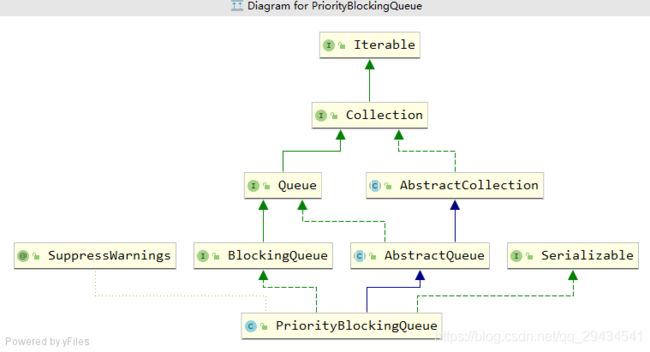JUC-并发编程-08-阻塞队列BlockingQueue之-PriorityBlockingQueue
PriorityBlockingQueue是一个支持优先级的无界阻塞队列,直到系统资源耗尽。默认情况下元素采用自然顺序升序排列。也可以自定义类实现compareTo()方法来指定元素排序规则,或者初始化PriorityBlockingQueue时,指定构造参数Comparator来对元素进行排序。但需要注意的是不能保证同优先级元素的顺序。PriorityBlockingQueue也是基于最小二叉堆实现,使用基于CAS实现的自旋锁来控制队列的动态扩容,保证了扩容操作不会阻塞take操作的执行。我们在数据结构地方学习过优先队列。树与优先队列
源码分析
1、继承关系
2、属性介绍
// 默认容量为11
private static final int DEFAULT_INITIAL_CAPACITY = 11;
// 最大数组大小
private static final int MAX_ARRAY_SIZE = Integer.MAX_VALUE - 8;
// 存储元素的地方
private transient Object[] queue;
// 元素个数
private transient int size;
// 比较器
private transient Comparator comparator;
// 重入锁
private final ReentrantLock lock;
// 非空条件
private final Condition notEmpty;
// 扩容的时候使用的控制变量,CAS更新这个值,谁更新成功了谁扩容,其它线程让出CPU
private transient volatile int allocationSpinLock;
// 不阻塞的优先级队列,非存储元素的地方,仅用于序列化/反序列化时
private PriorityQueue q; 总结:1、依然是使用一个数组来使用元素;2、使用一个锁加一个notEmpty条件来保证并发安全;3、使用一个变量的CAS操作来控制扩容;
3、主要构造方法
// 默认容量为11
public PriorityBlockingQueue() {
this(DEFAULT_INITIAL_CAPACITY, null);
}
// 传入初始容量
public PriorityBlockingQueue(int initialCapacity) {
this(initialCapacity, null);
}
// 传入初始容量和比较器
// 初始化各变量
public PriorityBlockingQueue(int initialCapacity,
Comparator comparator) {
if (initialCapacity < 1)
throw new IllegalArgumentException();
this.lock = new ReentrantLock();
this.notEmpty = lock.newCondition();
this.comparator = comparator;
this.queue = new Object[initialCapacity];
}4、入队
public boolean offer(E e) {
// 元素不能为空
if (e == null)
throw new NullPointerException();
final ReentrantLock lock = this.lock;
// 加锁
lock.lock();
int n, cap;
Object[] array;
// 判断是否需要扩容,即元素个数达到了数组容量
while ((n = size) >= (cap = (array = queue).length))
tryGrow(array, cap);
try {
Comparator cmp = comparator;
// 根据是否有比较器选择不同的方法
if (cmp == null)
siftUpComparable(n, e, array);
else
siftUpUsingComparator(n, e, array, cmp);
// 插入元素完毕,元素个数加1
size = n + 1;
// 唤醒notEmpty条件
notEmpty.signal();
} finally {
// 解锁
lock.unlock();
}
return true;
}
private static void siftUpComparable(int k, T x, Object[] array) {
Comparable key = (Comparable) x;
while (k > 0) {
// 取父节点
int parent = (k - 1) >>> 1;
// 父节点的元素值
Object e = array[parent];
// 如果key大于父节点,堆化结束
if (key.compareTo((T) e) >= 0)
break;
// 否则,交换二者的位置,继续下一轮比较
array[k] = e;
k = parent;
}
// 找到了应该放的位置,放入元素
array[k] = key;
} 总结下来就是:1、加锁 2、判断是否需要扩容 3、添加元素并做自下而上的堆化 4、元素个数加1并唤醒notEmpty条件,唤醒取元素的线程 5、解锁
5、扩容
private void tryGrow(Object[] array, int oldCap) {
// 先释放锁,因为是从offer()方法的锁内部过来的
// 这里先释放锁,使用allocationSpinLock变量控制扩容的过程
// 防止阻塞的线程过多
lock.unlock(); // must release and then re-acquire main lock
Object[] newArray = null;
// CAS更新allocationSpinLock变量为1的线程获得扩容资格
if (allocationSpinLock == 0 &&
UNSAFE.compareAndSwapInt(this, allocationSpinLockOffset,
0, 1)) {
try {
// 旧容量小于64则翻倍,旧容量大于64则增加一半
int newCap = oldCap + ((oldCap < 64) ?
(oldCap + 2) : // grow faster if small
(oldCap >> 1));
// 判断新容量是否溢出
if (newCap - MAX_ARRAY_SIZE > 0) { // possible overflow
int minCap = oldCap + 1;
if (minCap < 0 || minCap > MAX_ARRAY_SIZE)
throw new OutOfMemoryError();
newCap = MAX_ARRAY_SIZE;
}
// 创建新数组
if (newCap > oldCap && queue == array)
newArray = new Object[newCap];
} finally {
// 相当于解锁
allocationSpinLock = 0;
}
}
// 只有进入了上面条件的才会满足这个条件
// 意思是让其它线程让出CPU
if (newArray == null) // back off if another thread is allocating
Thread.yield();
// 再次加锁
lock.lock();
// 判断新数组创建成功并且旧数组没有被替换过
if (newArray != null && queue == array) {
// 队列赋值为新数组
queue = newArray;
// 并拷贝旧数组元素到新数组中
System.arraycopy(array, 0, newArray, 0, oldCap);
}
}- 解锁,解除offer()方法中加的锁;
- 使用allocationSpinLock变量的CAS操作来控制扩容的过程;
- 旧容量小于64则翻倍,旧容量大于64则增加一半;
- 创建新数组;
- 修改allocationSpinLock为0,相当于解锁;
- 其它线程在扩容的过程中要让出CPU;
- 再次加锁;
- 新数组创建成功,把旧数组元素拷贝过来,并返回到offer()方法中继续添加元素操作;
6、出队
阻塞队列的出队方法也有四个,我们这里只分析一个take()方法:
public E take() throws InterruptedException {
final ReentrantLock lock = this.lock;
// 加锁
lock.lockInterruptibly();
E result;
try {
// 队列没有元素,就阻塞在notEmpty条件上
// 出队成功,就跳出这个循环
while ( (result = dequeue()) == null)
notEmpty.await();
} finally {
// 解锁
lock.unlock();
}
// 返回出队的元素
return result;
}
private E dequeue() {
// 元素个数减1
int n = size - 1;
if (n < 0)
// 数组元素不足,返回null
return null;
else {
Object[] array = queue;
// 弹出堆顶元素
E result = (E) array[0];
// 把堆尾元素拿到堆顶
E x = (E) array[n];
array[n] = null;
Comparator cmp = comparator;
// 并做自上而下的堆化
if (cmp == null)
siftDownComparable(0, x, array, n);
else
siftDownUsingComparator(0, x, array, n, cmp);
// 修改size
size = n;
// 返回出队的元素
return result;
}
}
private static void siftDownComparable(int k, T x, Object[] array,
int n) {
if (n > 0) {
Comparable key = (Comparable)x;
int half = n >>> 1; // loop while a non-leaf
// 只需要遍历到叶子节点就够了
while (k < half) {
// 左子节点
int child = (k << 1) + 1; // assume left child is least
// 左子节点的值
Object c = array[child];
// 右子节点
int right = child + 1;
// 取左右子节点中最小的值
if (right < n &&
((Comparable) c).compareTo((T) array[right]) > 0)
c = array[child = right];
// key如果比左右子节点都小,则堆化结束
if (key.compareTo((T) c) <= 0)
break;
// 否则,交换key与左右子节点中最小的节点的位置
array[k] = c;
k = child;
}
// 找到了放元素的位置,放置元素
array[k] = key;
}
} - 加锁;
- 判断是否出队成功,未成功就阻塞在notEmpty条件上;
- 出队时弹出堆顶元素,并把堆尾元素拿到堆顶;
- 再做自上而下的堆化;
- 解锁;
总结
- PriorityBlockingQueue使用一个锁+一个notEmpty条件控制并发安全;
- PriorityBlockingQueue扩容时使用一个单独变量的CAS操作来控制只有一个线程进行扩容;
- 入队使用自下而上的堆化;
- 出队使用自上而下的堆化;
- PriorityBlockingQueue在入队的时候如果没有空间了是会自动扩容的,也就不存在队列满了的状态,也就是不需要等待通知队列不满了可以放元素了,所以也就不需要notFull条件了。
